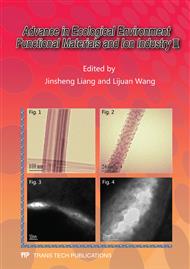p.104
p.110
p.115
p.119
p.123
p.128
p.133
p.139
p.143
Property of Nanoporous Metal-Organic Frameworks at Different Synthesis Temperature
Abstract:
The nanoporous metal-organic frameworks were synthesized under solvothermal conditions using organic solvent dimethylformamide. The samples were characterized by XRD, SEM, TGA, FT-IR and specific surface area for their properties difference. When the reaction temperature rises, the particle size becomes larger. All TGA curves are the basically same, the framework structure begins to be destroyed from 500°C up to around 600°C. The metal-organic frameworks accepted at reaction temperature 190°C have larger specific surface area and better structure stability.
Info:
Periodical:
Pages:
123-127
Citation:
Online since:
January 2012
Authors:
Price:
Сopyright:
© 2012 Trans Tech Publications Ltd. All Rights Reserved
Share:
Citation:


